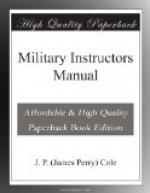[Illustration: Plate #12 DIAGRAM OF OUTPOST LINE]
Outline of Field Service Regulations.
LAND FORCES OF U.S.
Regular Army.
Organized Land Militia.
Volunteer forces.
How Grouped:
Mobile Army.
Coast Artillery.
Mobile Army:
For offensive operations against enemy and so requires maximum degree of mobility.
Basis of organization the division, a self-contained unit composed of all necessary arms and services.
Coast Artillery:
(1) Permanent fortifications for
defense against naval attack.
(2) Semi-permanent fortifications
for protection of permanent from
raiders.
(3) Organization of mobile troops
to prevent landing of enemy.
MILITARY INFORMATION.
Essential:
(1) To enable War Department to
estimate equipment and size of force
necessary.
(2) To enable commander properly
to estimate the situation in the
field of operations.
TRANSMISSION OF INFORMATION.
Wire, Signaling, Radio and Messenger:
Message.—Concise, written
information sent by messenger or wire.
Source always given.—“Heard”
separated from “seen.”
Report.—Formal account
of some enterprise.
War Diary.—Record of
events kept in campaigns.
Maps.
Reconnaissance:
The work of individuals or units
in gathering information.
To keep contact with the enemy—to
be acquainted with the terrain;
to protect flanks and rear and guard against surprise.
Reconnaissance begins on entering
theater of operations and lasts
through campaign.
Effected by patrols and air craft.
Indications of enemy:
Tracks on road.
Abandoned camps and clothing.
Infantry, thick, low cloud of dust.
Cavalry, high, thin cloud of dust.
Artillery and wagons, broken cloud.
Determination of Enemy Forces:
Timing past a given point.
Cavalry (walk), 110 per minute.
Cavalry (trot), 200 per minute.
Infantry, 175 per minute.
Artillery and wagons, 5 per minute.




